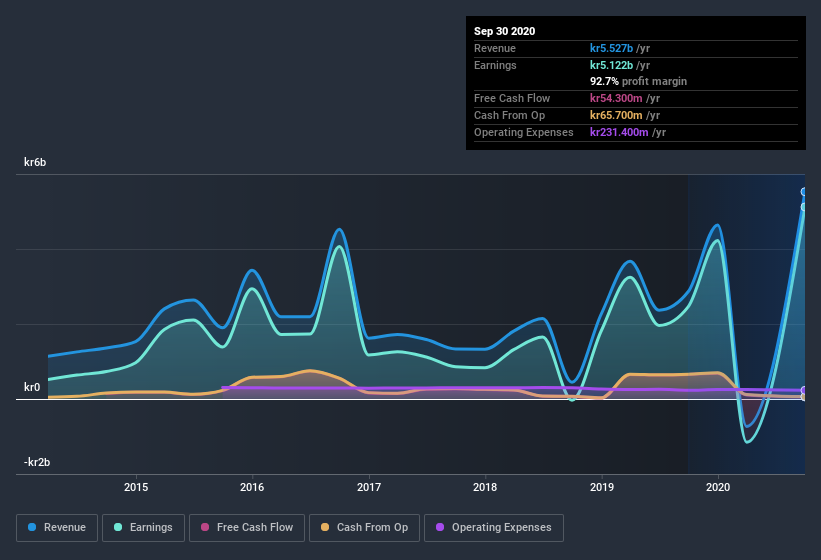
For beginners, it can seem like a good idea (and an exciting prospect) to buy a company that tells a good story to investors, even if it completely lacks a track record of revenue and profit. Unfortunately, high risk investments often have little probability of ever paying off, and many investors pay a price to learn their lesson.
In the age of tech-stock blue-sky investing, my choice may seem old fashioned; I still prefer profitable companies like Bure Equity (STO:BURE). While profit is not necessarily a social good, it's easy to admire a business that can consistently produce it. In comparison, loss making companies act like a sponge for capital - but unlike such a sponge they do not always produce something when squeezed.
Check out our latest analysis for Bure Equity
Bure Equity's Improving Profits
Over the last three years, Bure Equity has grown earnings per share (EPS) like young bamboo after rain; fast, and from a low base. So I don't think the percent growth rate is particularly meaningful. Thus, it makes sense to focus on more recent growth rates, instead. Like the last firework on New Year's Eve accelerating into the sky, Bure Equity's EPS shot from kr35.99 to kr72.69, over the last year. Year on year growth of 102% is certainly a sight to behold. That could be a sign that the business has reached a true inflection point.
Careful consideration of revenue growth and earnings before interest and taxation (EBIT) margins can help inform a view on the sustainability of the recent profit growth. I note that Bure Equity's revenue from operations was lower than its revenue in the last twelve months, so that could distort my analysis of its margins. Bure Equity shareholders can take confidence from the fact that EBIT margins are up from 86% to 93%, and revenue is growing. That's great to see, on both counts.
In the chart below, you can see how the company has grown earnings, and revenue, over time. Click on the chart to see the exact numbers.

While it's always good to see growing profits, you should always remember that a weak balance sheet could come back to bite. So check Bure Equity's balance sheet strength, before getting too excited.
Are Bure Equity Insiders Aligned With All Shareholders?
Like that fresh smell in the air when the rains are coming, insider buying fills me with optimistic anticipation. That's because insider buying often indicates that those closest to the company have confidence that the share price will perform well. However, small purchases are not always indicative of conviction, and insiders don't always get it right.
We haven't seen any insiders selling Bure Equity shares, in the last year. With that in mind, it's heartening that Sarah McPhee, the Independent Director of the company, paid kr132k for shares at around kr131 each.
Along with the insider buying, another encouraging sign for Bure Equity is that insiders, as a group, have a considerable shareholding. Notably, they have an enormous stake in the company, worth kr5.4b. That equates to 25% of the company, making insiders powerful and aligned with other shareholders. So it might be my imagination, but I do sense the glimmer of an opportunity.
While insiders already own a significant amount of shares, and they have been buying more, the good news for ordinary shareholders does not stop there. That's because on our analysis the CEO, Henrik Blomquist, is paid less than the median for similar sized companies. For companies with market capitalizations between kr16b and kr53b, like Bure Equity, the median CEO pay is around kr9.0m.
Bure Equity offered total compensation worth kr7.6m to its CEO in the year to . That comes in below the average for similar sized companies, and seems pretty reasonable to me. CEO remuneration levels are not the most important metric for investors, but when the pay is modest, that does support enhanced alignment between the CEO and the ordinary shareholders. I'd also argue reasonable pay levels attest to good decision making more generally.
Should You Add Bure Equity To Your Watchlist?
Bure Equity's earnings per share have taken off like a rocket aimed right at the moon. The incing on the cake is that insiders own a large chunk of the company and one has even been buying more shares. Because of the potential that it has reached an inflection point, I'd suggest Bure Equity belongs on the top of your watchlist. You still need to take note of risks, for example - Bure Equity has 2 warning signs (and 1 which can't be ignored) we think you should know about.
As a growth investor I do like to see insider buying. But Bure Equity isn't the only one. You can see a a free list of them here.
Please note the insider transactions discussed in this article refer to reportable transactions in the relevant jurisdiction.
When trading Bure Equity or any other investment, use the platform considered by many to be the Professional's Gateway to the Worlds Market, Interactive Brokers. You get the lowest-cost* trading on stocks, options, futures, forex, bonds and funds worldwide from a single integrated account. Promoted
If you're looking to trade Bure Equity, open an account with the lowest-cost platform trusted by professionals, Interactive Brokers.
With clients in over 200 countries and territories, and access to 160 markets, IBKR lets you trade stocks, options, futures, forex, bonds and funds from a single integrated account.
Enjoy no hidden fees, no account minimums, and FX conversion rates as low as 0.03%, far better than what most brokers offer.
Sponsored ContentValuation is complex, but we're here to simplify it.
Discover if Bure Equity might be undervalued or overvalued with our detailed analysis, featuring fair value estimates, potential risks, dividends, insider trades, and its financial condition.
Access Free AnalysisThis article by Simply Wall St is general in nature. It does not constitute a recommendation to buy or sell any stock, and does not take account of your objectives, or your financial situation. We aim to bring you long-term focused analysis driven by fundamental data. Note that our analysis may not factor in the latest price-sensitive company announcements or qualitative material. Simply Wall St has no position in any stocks mentioned.
*Interactive Brokers Rated Lowest Cost Broker by StockBrokers.com Annual Online Review 2020
Have feedback on this article? Concerned about the content? Get in touch with us directly. Alternatively, email editorial-team (at) simplywallst.com.
About OM:BURE
Bure Equity
A private equity and venture capital firm specializing in secondary direct, later stage, middle market, mature, buyouts, emerging growth, expansion capital, mid venture, late venture, PIPES, bridge, industry consolidation, recapitalizations, growth capital, special situation and turnarounds.
Flawless balance sheet and good value.
Market Insights
Community Narratives



